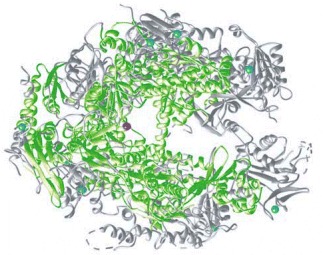From: From DNA to RNA

NCBI Bookshelf. A service of the National Library of Medicine, National Institutes of Health.

Regions of the two RNA polymerases that have similar structures are indicated in green. The eucaryotic polymerase is larger than the bacterial enzyme (12 subunits instead of 5), and some of the additional regions are shown in gray. The blue spheres represent Zn atoms that serve as structural components of the polymerases, and the red sphere represents the Mg atom present at the active site, where polymerization takes place. The RNA polymerases in all modern-day cells (bacteria, archaea, and eucaryotes) are closely related, indicating that the basic features of the enzyme were in place before the divergence of the three major branches of life. (Courtesy of P. Cramer and R. Kornberg.)
From: From DNA to RNA

NCBI Bookshelf. A service of the National Library of Medicine, National Institutes of Health.